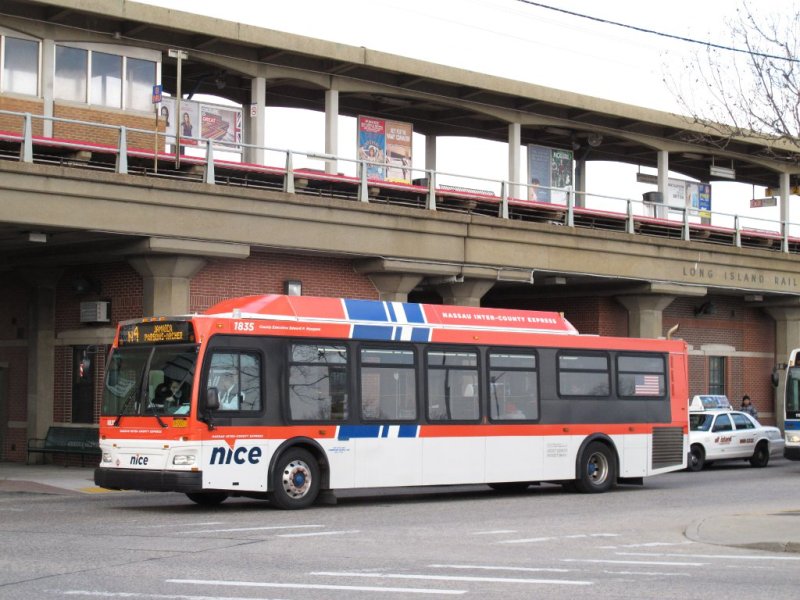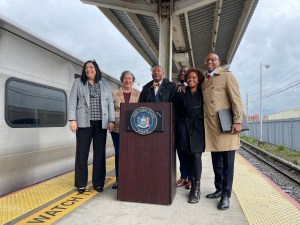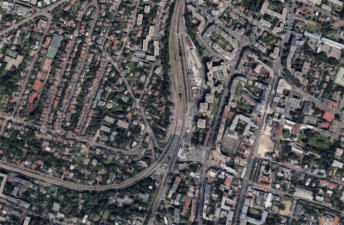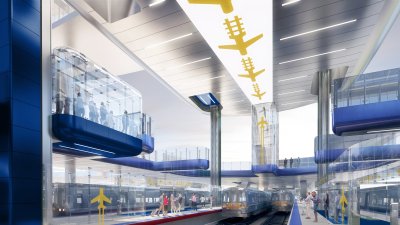On Long Island, Transit Operates as Two Separate and Unequal Systems
Major new rail infrastructure projects won't deliver on their potential if Long Island continues to operate its train and bus networks as a two-tiered transit system.

The Long Island Railroad is building some of the biggest infrastructure projects in the region — even the world. The hugely expensive East Side Access tunnel and terminal at Grand Central and the construction of a third track for the LIRR Main Line will open up new possibilities for convenient, all-day transit that people can use for all types of trips. But not if Long Island continues to operate its rail and bus networks as a two-tiered transit system.
Currently, the LIRR runs its trains to connect the suburbs of Nassau and Suffolk counties with New York City, especially Manhattan. The LIRR has schedules and park-and-rides that assume passengers are affluent car owners who take the train to get to their 9-to-5 Manhattan jobs.
For working class Long Islanders, the transit on offer is different. There’s a beleaguered bus system, the Nassau Inter-County Express (NICE), formerly known as Long Island Bus. NICE ridership, already at a 15-year low five years ago, has continued to fall.
Long Island’s two transit operators have separate fares and serve different markets, in what Stephen Smith calls transit apartheid. It’s a terrible way to run transit, and Long Island can do better.
Transit works best when all the pieces fit together: suburban and urban transit, trains and buses, infrastructure and operations planning. Decisions made about one aspect of transit affect other aspects in subtle but significant ways. When passengers can easily connect between commuter trains, subways, and buses, they benefit from a seamless experience.
Three aspects of transit integration are directly relevant to Long Island: fare integration, schedule integration, and integration between infrastructure and operations planning.
In European and East Asian cities, the best practice is to charge the same fare for a trip regardless of the type of vehicle, or how many transfers the trip takes. This means buses, subways, and commuter trains should charge the same fares, and use the same fare media, even if it’s paper tickets. Fares can vary based on geographic zones or distance traveled — or they can be flat within the entire metro area — but the way the passenger travels should not affect the fare. This is called mode-neutral fare.
Within New York City, subways and most MTA buses are fare-integrated, and there are free transfers. But the LIRR charges a premium fare in relation to NICE. This segments the market: Low-income riders take NICE, and middle- and high-income riders take the LIRR.
It doesn’t have to be this way. With their less Manhattan-centric travel patterns, low-income riders in Long Island could fill empty reverse- and off-peak trains, instead of crowding slow buses.
Schedules can also be integrated across different modes and operators. This entails planning how buses and trains connect, and avoiding destructive competition. The best industry practice is known as timed transfers: All transit services run on the same basic schedule (for example, every 15 or 30 minutes all day), and buses feed trains with timed connections.
There are no timed transfers on Long Island because of the market segmentation between NICE and the LIRR. The busiest LIRR stations in Nassau County act as NICE hubs, but the buses run on a different timetable, and are not timed to meet the trains; in some cases, they are timed to just miss the trains.
Finally, planners cannot make decisions regarding schedules, infrastructure, and rolling stock in isolation. The opening of a new rail extension may affect the market for bus service in the area. Or the introduction of high-performance trains may alter the optimal timetable on a rail line. Or, in the other direction, the switch to a different timetable may suggest new priority infrastructure investments.
The best practice is to plan all three aspects together. That’s why, for instance, referendums for local rail spending in Switzerland include precise service plan information.
Right now, the New York region is making massive investments in the LIRR, but there is no integrated planning to make the most of this spending.
The MTA’s East Side Access project will increase LIRR capacity into Manhattan by 50 percent when it opens and lead to dramatic changes in train operations. We know what some of those changes will be: The LIRR plans to cut off Brooklyn from mainline LIRR service and replace it with shuttle service, diverting all through-trains to the East Side Access tunnel. Today, there are timed cross-platform transfers at Jamaica between trains bound for Penn Station and trains bound for Brooklyn, but the reconstruction work at Jamaica will break the cross-platform transfer. Passengers will have to go up and then down stairs to change trains.
More detailed schedule information is scant. The LIRR says that during peak service, it plans to run 24 trains per hour into Grand Central via the new tunnel and 37 into Penn Station via the existing tunnels. But there is no public schedule, or any indication of how often trains will run on each branch to each Manhattan terminal.
The LIRR isn’t very concerned about optimal scheduling. The LIRR Main Line has two tracks. Peak train traffic would fit in one track in each direction, if all trains ran local. But the LIRR prefers running express trains instead of any reverse-peak service — as a result, trains run one-way during the peak. This makes the Main Line useless for reverse commutes, which disproportionately affects low-income riders who work in Mineola and live further west.
To add more flexibility, the LIRR is planning to add a third track to the Main Line. But the state has a promotional video talking about everything except good scheduling: adding parking, preventing delays, and allowing reverse-peak service. Unsaid is how frequent the reverse-peak service will be, or how off-peak service will change.
These scheduling questions matter especially to lower-income riders, who are more likely to have unpredictable travel patterns than 9-to-5, peak direction commuters who take the same train into the city each day. Can riders rely on the LIRR without memorizing a schedule? Can they use it for trips at all times of day? The lack of interest in answering these questions shows the LIRR’s priority is still suburban park-and-ride passengers who go to Manhattan in the morning and return in the afternoon.
There are two competing visions for transit on Long Island. One is the current policy, in which buses and trains serve different classes of riders, separate and unequal; trains exist exclusively to transport people who work in Manhattan and drive everywhere else; infrastructure and schedule planners do not coordinate. In such an environment, it’s likely that everyone who works outside Manhattan and can afford a car will get around primarily by driving.
The other vision is more integrated across different modes of transit, different social classes, and different aspects of planning. NICE, the subway, and the LIRR would charge the same fares, with free transfers, so riders could use whichever system makes the most sense for where they live and where they want to go.
NICE buses, running about every half hour, would be timed to meet LIRR trains at major stations with short transfer windows, and LIRR stations would be designed to minimize walking time between the bus and the train platforms. Infrastructure planning would be based on a well-publicized train schedule, offering frequent local service all day in both directions.
In this vision, Long Island would have a transit system based on the same principles underlying German and Swiss transit, and could expect similar results.



